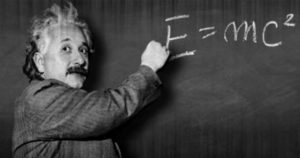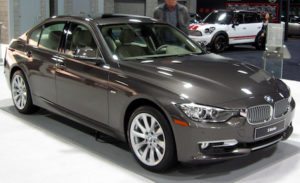About a century ago, car designations were easy to remember.
For example, what did Ford call the car that followed the Model A? The Model B. Simple.

Einstein only needed three letters and a number to share his big idea. Are vehicle designations really more complicated than this?
Fast forward to the 21st century, and suddenly you have enough of makes, models, designations and sub-designations to fill the world’s longest spreadsheet.
Every auto manufacturer has their own method for naming vehicles, and BMW is no different. Unlike carmakers who give a cutesy name to each of their offerings (Smart Fortwo, anyone?) Ultimate Driving Machines are typically classified with a three-digit number followed by one or two letters.
The first number represents the series number, and the next two numbers traditionally represent the engine displacement, measured in cubic centimeters divided by 100.
Series Number
Most BMW aficionados know that as the series number increases, so does the size (and price) of the car. But beyond that, the names and designations can leave the uninitiated scratching their heads.
As Cartelligent notes, BMW’s current lineup uses 10 distinct groupings. Sportier coupe-style vehicles are designated by even numbers (2, 4, and 6 Series) and sedan-style models are known by odd numbers (3, 5, and 7 Series).
That accounts for six out of 10 groupings. The remaining four BMWs are designated by letters:
- X Models: SUVs and crossovers
- Z4 Models: Two-door roadsters
- M Models: High-performance versions of other models (e.g. the high-performance 3 Series sedan is designated M3).
- BMW i: Electric and plug-in hybrid vehicles
Displacement Number

BMW 328i Sedan
Historically, the two digits of that followed the series number referred to the engine’s displacement size. For example, the 328i Sedan had a 2.8-liter engine.
As engine styles have changed, the numbers have been adjusted to approximate the engine’s performance. For example, the 328i Sedan has a 240-hp 2.0-liter Twin Power Turbo inline 4-cylinder engine while the 335i Sedan has a 300-hp 3.0-liter Twin Power Turbo inline 6-cylinder engine.
Letters
Of course, BMW designations aren’t limited to numbers and math. Each of the letters that follow the numbers represents a different type of engine, body style and platform.
According to BMW Blog, BMW’s letter designations include:
- c: convertible
- C: coupe
- d: diesel engine
- e: eta – power with economy
- g: compressed natural gas/CNG
- h: hydrogen engine
- i: fuel-injection
- L: long wheelbase
- s: sport
- t: hatchback
- T: touring/wagon
- x: xDrive system
Brands & Lines

BMW Alpina B7 xDrive
BMW offers a number of brand-specific vehicle models that expand on their standard styles. These include:
- Gran Coupe: A four-door version of a coupe, the Gran Coupe has the style of a smaller two-door vehicle with expanded space for comfort. The 4 Series and 6 Series are available as Gran Coupes.
- Gran Turismo: A four-door sedan with a higher driving position and a wagon-like trunk. This style is available in the 3 and 5 series.
- ALPINA Sedan & Gran Coupe: ALPINA is a separate company from BMW that produces a higher performance variant of the 6 Series and 7 Series. ALPINA vehicles are produced in BMW factories on their normal production lines.
Finally, BMW offers several specialized configurations to enhance and upgrade some models’ standard trim.
These lines include:
- Luxury Line: Upgrades include wheels, steering wheel, and interior trim.
- xLine: Available on select X models,features include wheels, roof rails, and steering wheel.
- Sport Line: Upgraded wheels, as well as a sports steering wheel and seats.
- M Sport Line: Adds features including M wheels, an M steering wheel, a sports instrument cluster and an M aerodynamic kit. Certain models on the M Sport Line also offer unique color choices.
The next time you’re eyeballing another Bimmer on the 405, think back to this post as to understand that car’s designation. Just don’t get too close to see what the numbers are – we don’t want to be responsible for any fender benders.




